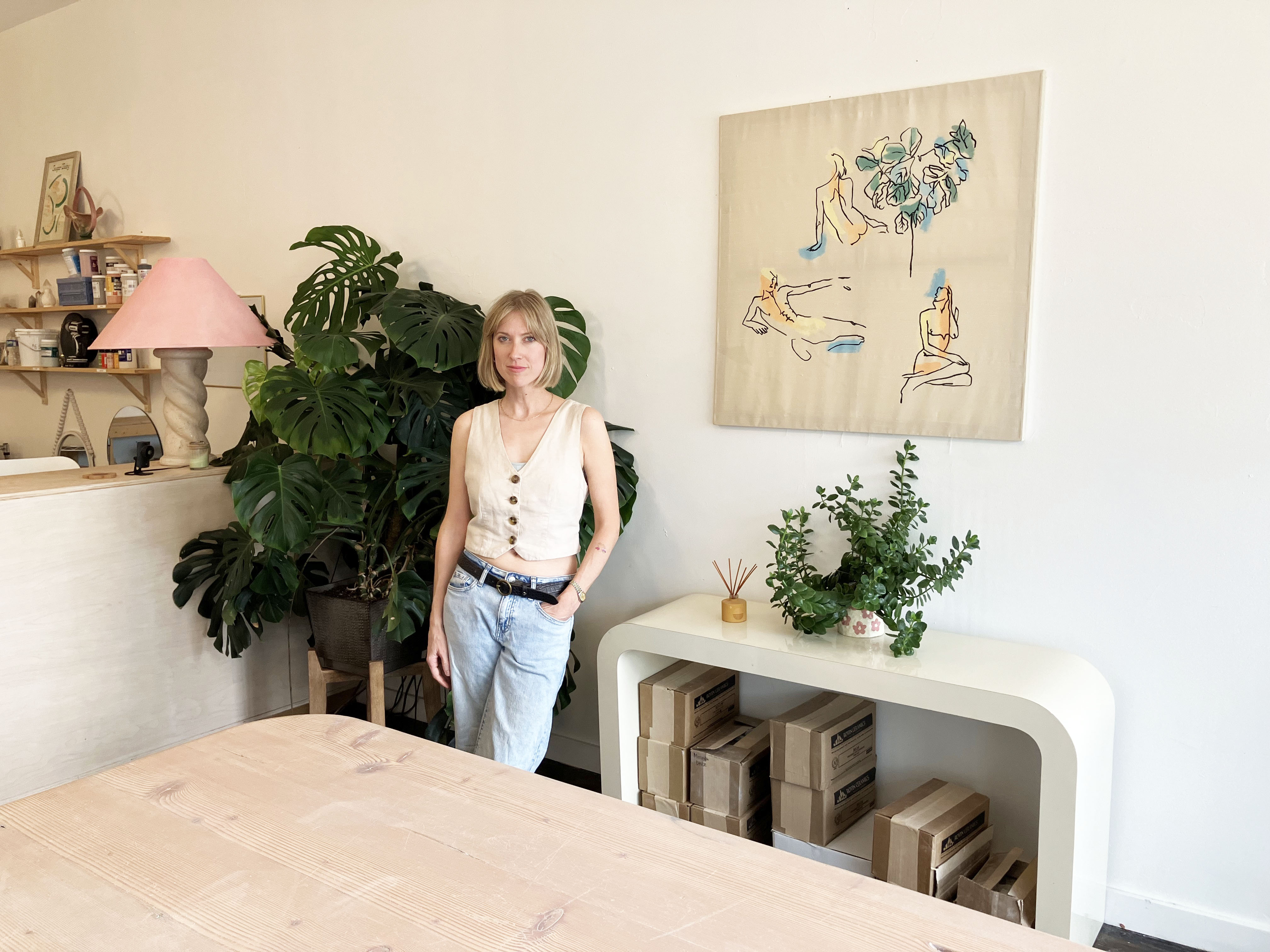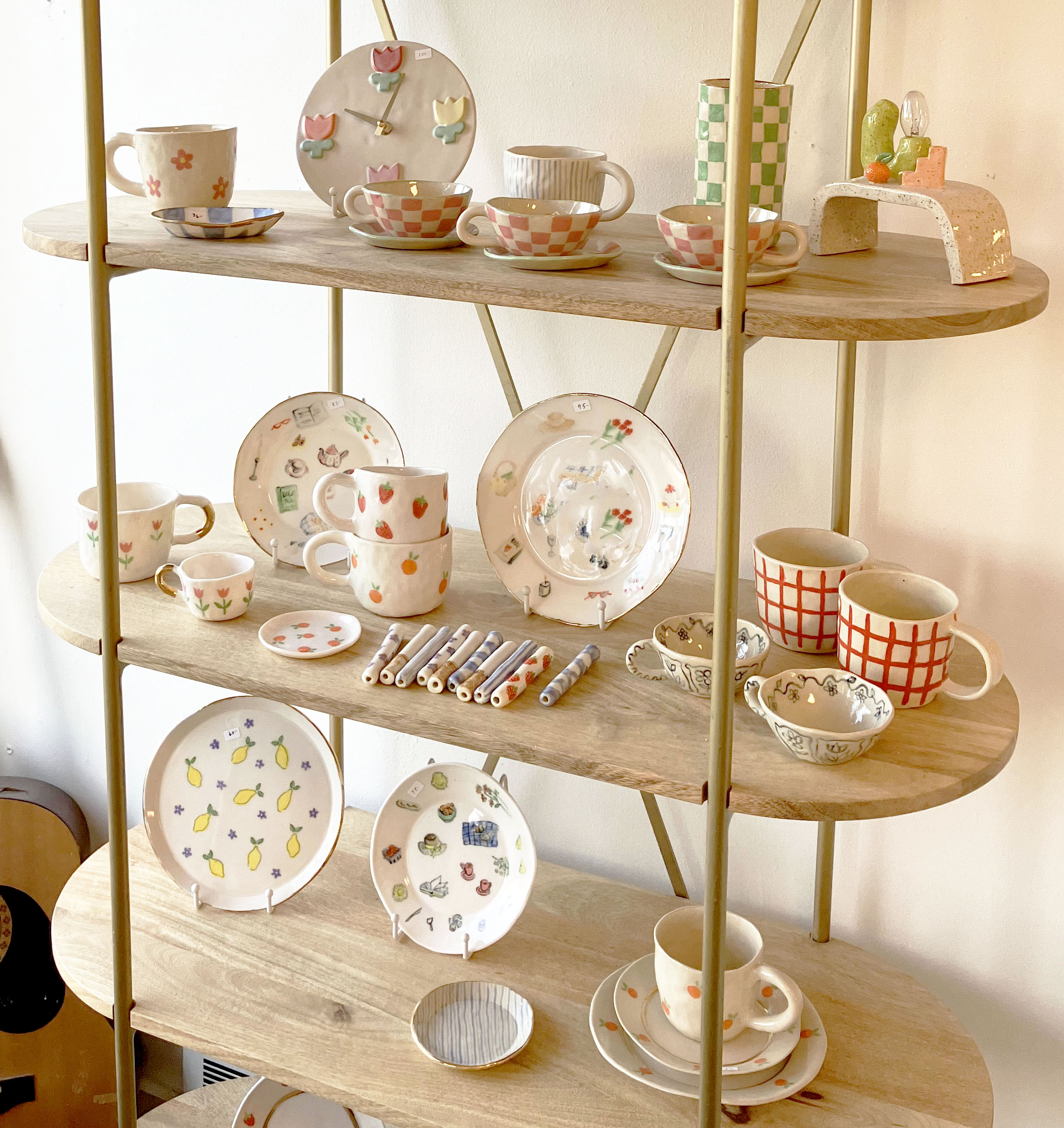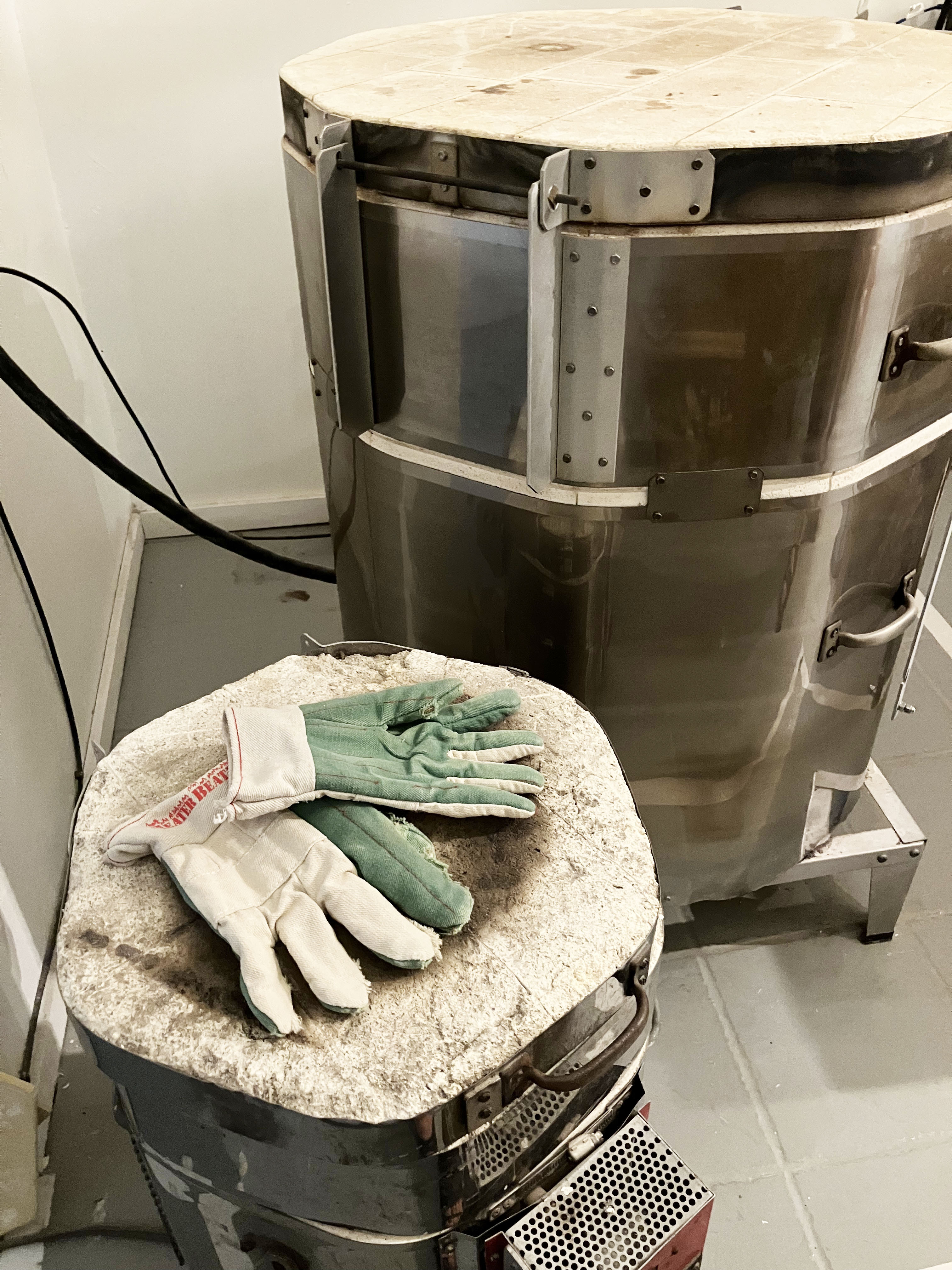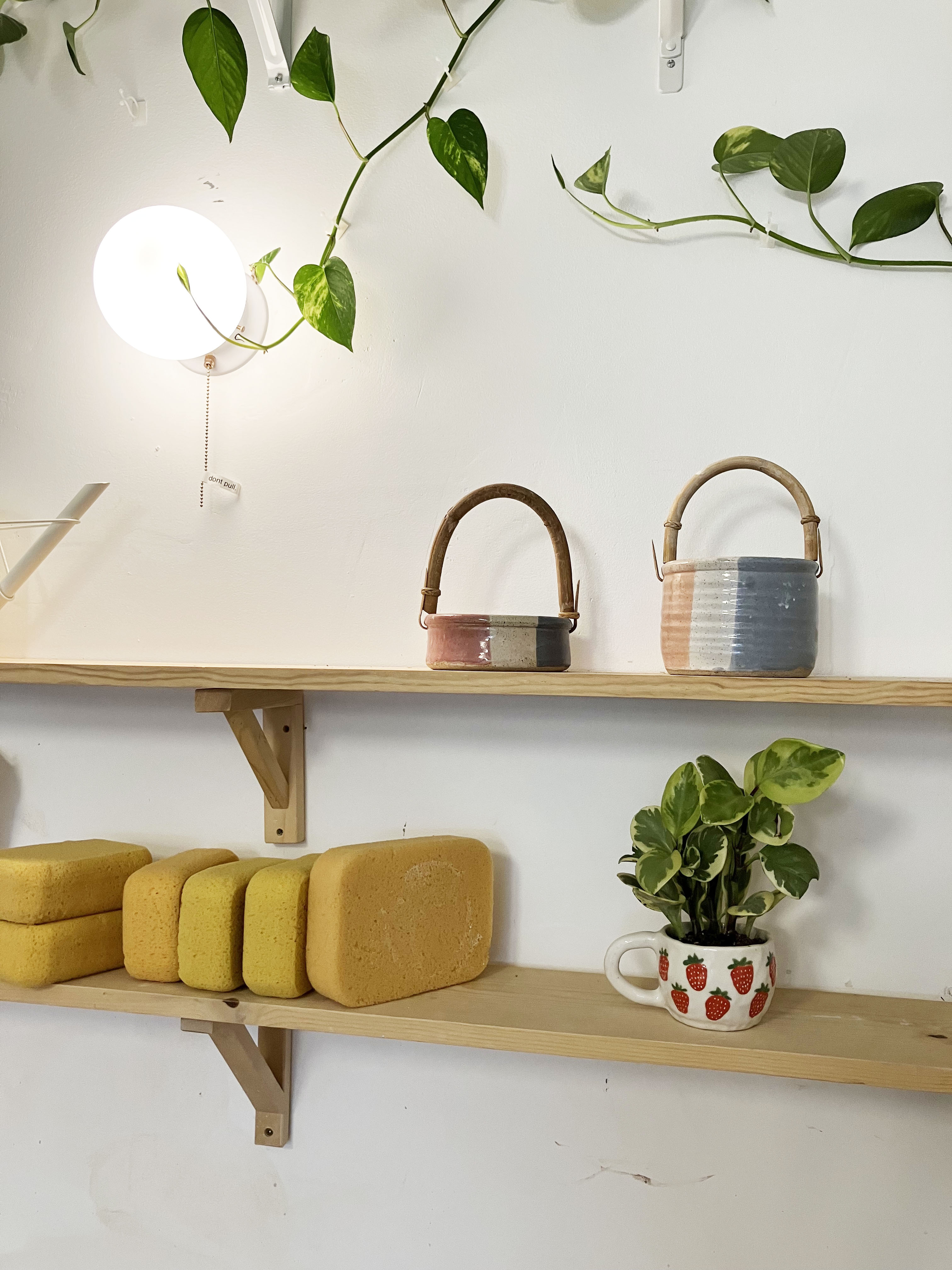
An interview with Vanessa Beard
August 26, 2024

With the history of ceramics being as old as humankind itself, it is pretty clear that it will continue to be around until we are gone. From culture to culture and era to era, we are able to observe the boundless possibilities of the craft in terms of both form and use. Hamtramck, Michigan is the home of a few different ceramic studios, with the newest one being Porcelinen. Vanessa Beard has been working as a ceramicist for many years, officially starting her business in 2019, and opening a storefront and studio in 2022. She embraces the organic growth of the entrepreneurial lifestyle, over time, becoming an expert studio manager, kiln technician and teacher. The vibe of her work recalls the aesthetic of the 80s as a default of her millennial status, refreshing the minimalist tendencies and curved edges that were buried decades ago. Although unintentional, it offers an experience of nostalgia that draws in both collectors and students. We had the opportunity to meet with Vanessa to discuss her experience as an artist and business owner in Detroit.

A: So, the practice of Porcelinen is something that you do in addition to working as a personal assistant. Does that work support Porcelinen? Or do the memberships here fully support the studio?
V: Yeah, so the personal assistant work that I do is really just extra hussle money for me. The studio itself, the cost of the storefront, the utilities, the furniture and equipment, and the security system are all financed by the memberships. I also have a backspace that functions as a private studio for an artist, which brings in money to support the studio.
Before starting Porcelinen, I had a studio at Greg Toms in South West. I was also a member at Ann Arbor Art Center, Birmingham Bloomfield Art Center and Sugar Hill. At Sugar Hill, I had a shelf, which included studio time and access to the kiln. I ended up adopting their model for Porcelinen. I rent out shelf space, which includes 24 hour access to the studio. I also fire all of their work for them. So far, it has been working out great.

A: What is the process of selecting members? Do you have a vetting process?
V: Usually, most members have been referred to me by a previous member. I also have friends who are members, but if I get a cold call or DM, I’ll just schedule an interview with them and ask them questions about their experience with ceramics, classes they have taken, if they were a member somewhere else before, what their expectations are regarding space, etc.
A: Is the firing of the kiln a big expense for the studio?
V: It has been manageable for the most part. But as part of my role as the studio manager, I also need to fix the kiln if something breaks, like replacing the element coils and relays, so that can get expensive for the parts, even if I am the one fixing it. After holding memberships at studios previously, I learned about the usual roles of ceramics studios, which include janitor, kiln tech, and teacher. I am currently fulfilling all of those roles.

A: So, obviously as a teacher, you provide guidance during your workshops on what will fire accurately, or what may be hazardous to fire, but for the members, do you expect that they know these things already?
V: Many of them are pretty independent, but I do give them gentle reminders if I think something could potentially fail.
A: There seems to be a community of ceramic studios in Hamtramck, with Ceramic School, and then also Hamtramck Ceramck…
V: Yes, they are all great, it is really rewarding and supportive to have these studios nearby. In the past when my kiln was broken, they have offered to fire some things for me and I appreciate that very much. I also learn alot from them about how to run a studio, and we all offer different things, which is nice. I actually became inspired to start offering shelfless memberships because I noticed that Ceramic School was doing that.
A: What does the shelfless membership entail?
V: The shelfless membership is for people who are making things at their home. They can use the studio but they keep all of their materials at home and transport it here to be bisqued and glaze fired. The studio has been a very organic evolution so far. In addition to adding the shelfless option for members, I am looking into offering more to my students, like adding different types of glazes.

A: For the classes, what are some of the things you focus on?
V: I started out with doing workshops focused on a specific form, like a cup, a vase, a pipe, chains. I was basing the workshops off of popular products I was selling. I held these workshops for about a year before introducing a full six-week course called Hand-building One, which incorporated basic techniques like slab-building, pinching and coil building. Those were the three fundamentals for that course, along with glazing. I have also started holding the Intermediate Hand-building course, which involves making more complex projects like baskets and bigger vases. In that course, we also use different decorating techniques like sgraffito, where we carve into the under-glazes.
A: Did you study ceramics?
V: I did not study it in school. I just learned through my experiences as a member and student at various studios throughout the years.
A: Being a teacher is such a complex role. It is one thing to do the work on your own, but it is another thing to communicate how to do it well enough for someone else to understand and repeat accurately. When planning the courses, what were some considerations that you made to ensure that it would fulfill the goal of the course and meet the needs of the students?
V: I started with baby-steps for the workshops, and there were definitely elements of reverse engineering. I began with doing workshops with only friends and family, and I charged them only the cost of materials. Those experiences helped me to learn how to effectively break down the processes I was trying to teach. I also watched YouTube videos of ceramic instructors to learn what kind of verbiage was being used. Over time, I became more articulate, understanding how to communicate directly with the students to help them improve their skills.
A: I am sure you have had challenging moments while trying to teach something to beginners…
V: Yes, there have definitely been moments where maybe a person is having fun with the material, missed a direction and suddenly there is a strange crisis that I swoop in to help with. There are also many times when someone will move the clay a certain way and I know that it would cause issues with the strength of the piece after firing, so I will encourage them to re-roll it and re-build it to avoid it becoming brittle. I have noticed that I really am a perfectionist, letting my students know about how the clay shrinks ten percent during the firing process, or if the glaze will not turn out how they are expecting that it would. Ultimately, I try to take the surprise element out of it as much as I can so that the students will be happy with the final outcome.

A: Yes, I do think that the element of surprise can be exciting for people who are new to ceramics too, though. Maybe it would be cool to hold a workshop that allows greater freedom, with a focus on not knowing what to expect…
V: I do like that idea. I did a workshop once with thirty people who showed up and had an hour to make something. I gave some quick tutorials and then said “ready-set-go”, and that was a lot of fun because it was really different then the super-structured workshops. It was also enjoyable and exciting to see what would come out of the kiln.
A: I feel like that’s a lot of how Hamtramck Ceramck works. Super spontaneous, wild, free form.
V: Yeah, it can lead to really refreshing work and can even lead to brand new ideas that you would have never thought of by working in a very structured and predictable way.
A: Ceramics is one of the oldest art forms of humankind. I wonder if the history of ceramics is something that you think about, or something that caused you to get into ceramics in the first place?
V: Absolutely, yes. I was always sort of a daydreamer. I grew up around alot of nature, picking leaves in my yard and pretending to make soups. One childhood memory that I think contributed to my love for ceramics is digging-up clay in this new development neighborhood where I lived and making little sculptures. It dried and I painted it too. There was something special about that experience, potentially leading me to romanticize ancient cultures that were connected to the earth.
Another significant memory is when this person I knew visited Arizona and brought home all of these shards of Hopi pottery (illegally). Of course, if you are in the desert and see something like that, you are supposed to leave it, but anyways, when I saw them, I was so enamored by the colors on them and how well kept it was even over so many years. It is funny that I was so excited by this, because these days, with plastic being as problematic as it is, we are trying to make things that don’t last forever…
Growing up, I also witnessed my mother having a love for pottery and collecting Polish pottery, which is from a more recent history, but yeah…
A: And was the name of the studio Porcelinen chosen to highlight and celebrate porcelain specifically?

V: Porcelain is my favorite material. I started reading a book recently about its history, called The White Road. The author of the book, Edmund de Waal also has a love for porcelain and did in depth research on where it developed and how it has been used throughout time. I just love how fine porcelain is, it can be made the most thin. It is so delicate but also the most impervious, which is why it can be used in a variety of industries. And as an illustrator and someone who loves painting, I also love porcelain because the colors pop on it the most. It is the brightest white and the smoothest of clays.
A: The most delicate and the most strong. That’s pretty nice as a metaphor.
V: It is, and I think that is what compels me towards it.